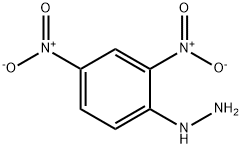2,4-Dinitrophenylhydrazine
- CAS No.
- 119-26-6
- Chemical Name:
- 2,4-Dinitrophenylhydrazine
- Synonyms
- DNPH;2,4-DINITROPHENYLHYDRAZINE;2,4-DNPH;(2,4-dinitrophenyl)-hydrazin;DINITROPHENYL HYDRAZINE;2,4-Dinitrofenylhydrazin;2,4-dinitrophenyl-hydrazin;2,4-Dinitrophenylhydrazine, 97%, moist with 30-35% water;2,4-Dinitrophenylhydrazine, reagent grade, with 30 - 35% of H2O;DNP
- CBNumber:
- CB4852908
- Molecular Formula:
- C6H6N4O4
- Molecular Weight:
- 198.14
- MDL Number:
- MFCD00007578
- MOL File:
- 119-26-6.mol
- MSDS File:
- SDS
| Melting point | 197-200 °C (lit.) |
|---|---|
| Boiling point | 335.43°C (rough estimate) |
| Density | 0.843 g/mL at 20 °C |
| refractive index |
n |
| Flash point | 14 °C |
| storage temp. | 2-8°C |
| solubility | 50% sulfuric acid: 10 mg/mL, clear, colorless |
| pka | 12.1(at 25℃) |
| form | crystals |
| color | Red |
| PH Range | Yellow (11.0) to brown (12.5) |
| Water Solubility | slightly soluble |
| Merck | 14,3283 |
| BRN | 615586 |
| Stability | Stable when wet, but explosive when dry. May be shock sensitive when dry. Highly flammable. Incompatible with strong oxidizing agents. |
| Major Application | Fuel cells, detecting microorganisms, antibacterial agent, treatment of acuteand chronic hepatitis, gynecopathy, cardiovascular diseases, cerebrovascular diseases |
| InChIKey | HORQAOAYAYGIBM-UHFFFAOYSA-N |
| CAS DataBase Reference | 119-26-6(CAS DataBase Reference) |
| FDA UNII | 1N39KD7QPJ |
| NIST Chemistry Reference | Hydrazine, (2,4-dinitrophenyl)-(119-26-6) |
| EPA Substance Registry System | 2,4-Dinitrophenylhydrazine (119-26-6) |
SAFETY
Risk and Safety Statements
| Symbol(GHS) |   GHS02,GHS07 |
|||||||||
|---|---|---|---|---|---|---|---|---|---|---|
| Signal word | Danger | |||||||||
| Hazard statements | H206-H302 | |||||||||
| Precautionary statements | P210-P212-P230-P233-P280-P370+P380+P375-P501 | |||||||||
| Hazard Codes | F,Xn | |||||||||
| Risk Statements | 1-11-22-40-2001/11/22 | |||||||||
| Safety Statements | 35-48A-45-36/37-16 | |||||||||
| RIDADR | UN 3380 4.1/PG 1 | |||||||||
| WGK Germany | 3 | |||||||||
| RTECS | MV3325000 | |||||||||
| F | 8 | |||||||||
| HazardClass | 4.1 | |||||||||
| PackingGroup | II | |||||||||
| HS Code | 29280000 | |||||||||
| NFPA 704 |
|
2,4-Dinitrophenylhydrazine Chemical Properties,Uses,Production
Description
2,4-Dinitrophenylhydrazine (abbreviated 2,4-DNP for short) is the chemical compound C6H3 (NO2) 2NHNH2, and it is often used to qualitatively test for carbonyl groups associated with aldehydes and ketones. The hydrazone derivatives can also be used as evidence toward the identity of the original compound. It is relatively sensitive to shock and friction; it is a shock explosive, so care must be taken with its use. To reduce its explosive hazard, it is usually supplied wet.
2,4-Dinitrophenylhydrazine is a compound with a benzene ring, two Nitro groups, and a hydrazine (two nitrogen atoms bonded directly to each other) functional group. It is used as a Brady's reagent to test the existing of a ketone or aldehyde.
Chemical Properties
white to light yellow crystal powde
Uses
2,4-Dinitrophenylhydrazine has been used as a reagent to detect the presence of aldehydes and ketones in protein carbonyls. It may be used as a colorimetric reagent in the quantitative estimation of prednisone.
Uses
2,4-Dinitrophenylhydrazine is known was Brady's reagent, a substituted hydrazine that is often used for qualitative testing of carbonyl groups associated with aldehydes and ketones.
Definition
ChEBI: 2,4-dinitrophenylhydrazine is a C-nitro compound that is phenylhydrazine substituted at the 2- and 4-positions by nitro groups. It has a role as a reagent. It is a member of phenylhydrazines and a C-nitro compound.
General Description
2,4-Dinitrophenylhydrazine (DNPH), a hydrazine derivative, is a potential mutagenic agent. Its molecular and crystal structure has been analyzed. The intra- and intermolecular hydrogen bonds in DNPH have been investigated by vibrational spectroscopic analysis. The mechanism of isothermal degradation of DNPH has been studied by differential scanning calorimetry (DSC).
Hazard
2,4-Dinitrophenylhydrazine [119-26-6] is a flammable solid, which must be kept moist and is harmful if swallowed, inhaled, or absorbed through the skin. Concentrated sulfuric acid [7664-93-9] is poisonous and corrosive. Its mist can cause severe burns to all body tissue. It may be fatal if swallowed or by skin contact. It is harmful if inhaled and may cause cancer. Ethanol [64-17-5] is flammable and should be kept from ignition sources. Eye and face protection, protective clothing, and gloves must be worn.
Purification Methods
Crystallise DNPH from butan-1-ol, dioxane, EtOH, *C6H6 or EtOAc. The hydrochloride has m 186o (dec). [Beilstein 15 IV 380.]
References
1. SOME LIMITATIONS OF 2,4-DINITROPHENYLHYDRAZINE AS A REAGENT FOR CARBONYL GROUPS. DOI:10.1021/JO01226A003
2. Linstromberg, W. W.; Baumgarten, H. E. Organic Experiments, 6th ed.; Houghton Mifflin: Boston, 2002; p 175. Shriner, R. L.; Hermann, C. K. F.; Morrill, T. C.; Curtin, D. Y.; Fuson, R. C. The Systematic Identification of Organic Compounds, 8th ed.; Wiley; Hoboken, NJ, 2004; pp 278–279.
3. An Improved Preparation of 2,4-Dinitrophenylhydrazine Reagent. DOI:10.1021/ED082P1310.2
2,4-Dinitrophenylhydrazine Preparation Products And Raw materials
Related articles
- The reaction of 2,4-Dinitrophenylhydrazine to test the existing of aldehyde or ketone
- 2,4-Dinitrophenylhydrazine (abbreviated 2,4-DNP for short) is the chemical compound C6H3 (NO2) 2NHNH2, and it is often used to....
- Mar 2,2020
119-26-6(2,4-Dinitrophenylhydrazine)Related Search:
1of4





